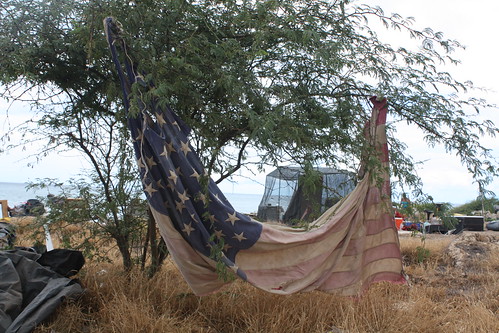State plan to fight ‘homelessness’ starts with identifying population, assessing shelters
HONOLULU—The State administration unveiled yesterday a 90-Day Plan as part of a larger mission to end “homelessness.” The plan focuses on identifying the types of people who are houseless and assessing the status of Hawaii’s shelters.
Gov. Neil Abercrombie and Marc Alexander, the governor’s Coordinator on Homelessness, said the plan takes a critical step. The 90-Day Plan coordinates government, non-profits, community and faith-based organizations, businesses, shelter and outreach services, and citizens to increase opportunities for people who are houseless to receive services.
“We have to be coordinated and collaborative in our approach to ‘homelessness’ so we can face this challenge as a society,” Abercrombie said at a press conference. “This plan is about taking immediate action together.”
To read the 90-Day Plan, click here
The plan outlines nine specific objectives:
1. Identify and assess people who are chronically homeless for immediate services in Waikiki and the urban core of Honolulu.
2. Support the chronically homeless and chronically mentally ill who need mental health treatment.
3. Identify available substance abuse treatment services and gaps in services to maximize access for the chronically homeless in need.
4. Identify and provide outreach as early as possible where persons who are homeless are established or increasing in number.
5. Coordinate community efforts to maintain clean public areas.
6. Ensure that existing shelters are maximized for capacity and service.
7. Provide information about sound relocation and financial planning, including Hawai’i’s high cost of living, to individuals and families outside of Hawai’i who inquire about the availability of services.
8. Establish the State Interagency Council on Homelessness.
9. Educate the general public about the most effective means to eliminate homelessness.
A “chronic homeless” person by federal definition is “an unaccompanied homeless individual with a disabling condition who has either been continuously homeless for a year or more, or has at least four episodes of homelessness in the past three years.” This definition has been adopted by the U.S. Department of Housing and Urban Development (HUD).
A new State Interagency Council on Homelessness will be formed to address broader issues, such as affordable housing strategies, in a long-term, statewide plan.
“All of us in the nonprofit community are aware of the magnitude of the challenges, but we are invigorated by the attention paid and efforts undertaken by the Governor and his team,” said Darryl Vincent, Chair of Partners in Care and the local Director of U.S. Vets, a non-profit serving houseless and at-risk veterans.
The 90-Day Plan will utilize existing resources and does not rely on any additional government funding, officials said. The State and other agencies will seek partnerships with the private sector, emphasizing a shared commitment from the entire community.
According to 2007 data, Hawaii has twice as many people who are “homeless” per 100,000 people as the national average. Almost one-third of the sheltered “homeless” are children; more than ten percent are veterans; and over 60 percent have lived in Hawaii for more than 10 years. Almost half of the families who are homeless include someone who is employed, and almost 30 percent are Hawaiian or part-Hawaiian.
“Homeless” shelter capacity in Hawaii has doubled since 2006, according to DHS. Of the 5,800 houseless people counted in the most recent point-in-time survey, 3,500 are in shelters and 2,200 are unsheltered.
There are 1,374 unsheltered people on Oahu alone: 394 in the Downtown district (from Salt Lake to Piikoi), 307 in East Honolulu (from Piikoi to Hawaii Kai, including Waikiki), 76 from Ewa to Kapolei, 77 from Kaneohe to Waimanalo, 96 from Wahiawa to North Shore and Kahuku, 14 from Kahaluu to Kahuku, and 410 on the Waianae coast.
Alexander said, “Just as there is no single profile for someone who is ‘homeless,’ there are no simple solutions to ending homelessness. The exciting part of the 90-Day Plan is that it requires us to work together in new and creative ways to get the job done.”
The 90-Day Plan is a collaborative effort that includes the following statewide organizations:
Bridging The Gap
Waikiki Health Center
City & County of Honolulu Department of Community Services
Institute of Human Services
State Department of Human Services Homeless Programs
Waianae Community Outreach
Partners in Care
U.S. Vets
There are several call-in numbers for citizens who want to help a person who is houseless or may need health and safety intervention:
Waikiki Health Center’s Care-A-Van Program on Oahu: (808) 791-9359; [email protected]
HOPE Services on Hawaii Island: (808) 935-3050; [email protected]
Family Life Center on Maui: (808) 877-0880; [email protected]
Kauai Economic Opportunity: call (808) 245-4077, x228; [email protected]
Persons wishing to help someone must provide the following information:
* The location and time when the homeless individual is known to frequent the area
* A detailed description of the individual or group
* The caller’s contact information
After a report is made, an outreach team will be assigned to visit the person. Emails and calls can be placed 24 hours a day, seven days a week. Emails are preferred.
Related Stories:
Comment: Relating to the regulation of the poor and unwashed

Following beach eviction, Waianae man commits suicide